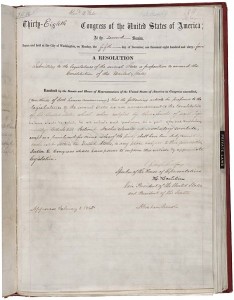| United States Constitution | |
|---|---|
 |
|
| The U.S. Constitution | |
| Preamble | |
| Articles of the Constitution | |
| I ‣ II ‣ III ‣ IV ‣ V ‣ VI ‣ VII | |
| Amendments to the Constitution | |
| Bill of Rights | |
| I ‣ II ‣ III ‣ IV ‣ V ‣ VI ‣ VII ‣ VIII ‣ IX ‣ X | |
| Additional Amendments | |
| XI ‣ XII ‣ XIII ‣ XIV ‣ XV ‣ XVI ‣ XVII ‣ XVIII ‣ XIX ‣ XX ‣ XXI ‣ XXII ‣ XXIII ‣ XXIV ‣ XXV ‣ XXVI ‣ XXVII | |
| View the Full Text | |
| Original Constitution | |
| Bill of Rights | |
| Additional Amendments |
The 13th Amendment to the United States Constitution came into force on December 6, 1865 after the ending of the American Civil War. The Amendment had been drafted during the Civil War, and had been approved by the Senate in April of the previous year. It was eventually passed by the House of Representatives in January 1865, having previously been rejected.
Text
Section 1. Neither slavery nor involuntary servitude, except as a punishment for crime whereof the party shall have been duly convicted, shall exist within the United States, or any place subject to their jurisdiction.
Section 2. Congress shall have power to enforce this article by appropriate legislation.
The Reconstruction Amendments
The 14th and 15th Amendments were passed in the following five years, and these three amendments are collectively known as the reconstruction Amendments. The 13th Amendment abolished slavery in the United States and everywhere under American jurisdiction.
The Amendment is a terse document, being just 43 words long. It declares that no person can be held in involuntary servitude or slavery by any group or individual. It declares one exception to allow for the punishment by imprisonment of lawfully convicted criminals. It also gives Congress the authority to introduce legislation to help enforce the amendment.
Background
 The issue of slavery was the root cause of the American Civil War. Slavery was a vital part of the commercial viability of many southern states, particularly in agricultural enterprises. Support for slavery elsewhere was less popular, especially in the northeastern states.
The issue of slavery was the root cause of the American Civil War. Slavery was a vital part of the commercial viability of many southern states, particularly in agricultural enterprises. Support for slavery elsewhere was less popular, especially in the northeastern states.
The 13th Amendment followed on from a number of previous attempts to introduce legislation to abolish slavery. These included efforts by John Quincy Adams in 1839 and later by Representatives James Mitchell Ashley, James F. Wilson and by Senator John B. Henderson.
In an attempt to consolidate the various proposals for abolition, a Senate Judiciary Committee drafted an amendment based on the proposals of Ashley, Wilson and Henderson, that was placed before the Senate and passed in April 1864, but rejected by the House of Representatives.
After the rejection by the House, Ashley reintroduced the amendment proposal. On this occasion, the proposed amendment was strongly supported by the President, Abraham Lincoln. Lincoln made the passing of the amendment one of the Republican Party’s policies in the presidential election campaign.
Lincoln felt that the Emancipation Proclamation, an executive order introduced by the United States government in 1863 was essentially ineffective and restricted because it applied to just the Confederate states. The Proclamation had declared that all slaves in the Confederate states were to be regarded as free by Federal forces.
Ratification
Lincoln’s endorsement of the proposed amendment meant the policy received more support, and it was successfully passed by the House of Representatives on the last day of January 1865.
On February 9, 1865, the state of Virginia became the first Confederate state to ratify the amendment. It is notable that the ratification in Virginia came before the end of the Civil War when Robert E. Lee surrendered the following April.
Most of the states ratified the amendment shortly after it was passed, but three states delayed ratification for significant periods. It was not ratified in Delaware until 1901, and in Kentucky until 1976, a full 131 years after it was passed. The last state to ratify the amendment was Mississippi in 1995, but the state failed to give official notification of the ratification to the U.S. Archivist, meaning the Mississippi ratification is still not official.